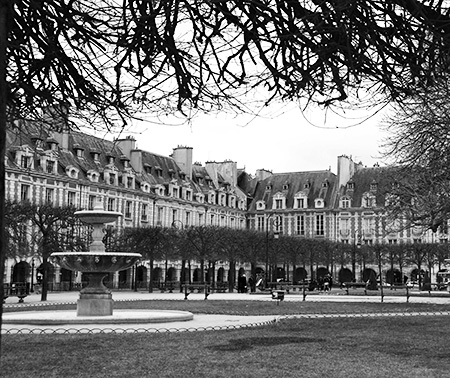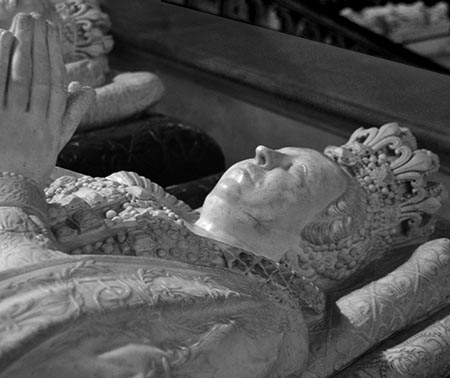
I received an advance copy of A Taste of Paris by David Downie from St. Martin’s Press; the book released this past week. When offered the book for review, my first question was, “Are there recipes?” No, it is “a history of the Parisian love affair with food,” which is, in fact, the subheading of the book. I love Paris. I love food. I said, yes.
I loved this book, in that way that makes you regret coming to its end. Reading history is not usually fun for me. But when it is a passionate read about one of my favorite subjects in one of my favorite places? Pure fun! Downie’s prose is witty, easy to read, and has just the right amount of snark to leaven the mix. He thinks of Paris as I do: “If I flipped a franc, it would land on something worth swallowing.”
 |
| Le Place des Vosges, an area of Paris that figures prominently in Downie’s book. |
The book is sequenced as if it were a 17th-century banquet menu: Aperitif, Starters, Entreés: Premier Service, Entrées: Second Service, etc. The book opens in 53 BC, and continues in AD 500 with the Medieval-Renaissance eras, goes on through the Medici years (early 1600s), then the age of Versailles, the Ancienne Nouvelle cuisine. From there it continues through the onslaught of restaurants dining in the 1800s, all the way through to the present, to a final chapter, the reader’s “Digestif,” wittily titled “Neo-Retro-Post-Postmodern Nouvelle d’Auteur”.
 |
| Tomb of Louis XVI & Marie Antionette, as seen before the “cake eating” incident. |
The legendary figures in this book – who so greatly influenced Parisian cuisine – are a veritable who’s who: the Kings Louis (XIV, XV, XVI, and XVIII), Catherine de Médicis, Parmentier, Brillat-Savarin, and Taillevent to name just a few.
 |
| The tomb of Catherine de Médicis (aka Caterina de Medici) at Saint Denis. |
One of the most valuable bits I gleaned from Downie is the existence of the Mazarin Library, hosted in the same building as the French Academy and the French Institute. It boasts a wonderful collection of rare culinaria, including Taillevent’s Le Viandier. “Certainly,” Downie writes, “it’s more practical to consult these fragile works online and I do. But seeing the slanting, swirling script and thick red capitals for each first letter of each recipe in Taillevent, feeling the wear marks made by long-dead fingers, smelling the distant smells of the original books so preciously preserved, turning the curled, yellowed, stained, and pocked pages, is another thing altogether.”
In this one book, I have folded down more page corners and highlighted more text than in all my college textbooks combined. I know A Taste of Paris is not written to be a guidebook, but I can’t wait to go back to Paris, my dog-eared copy in hand, to visit the many places cited by Downie. I am amazed to know how many of the historical restaurants of which he writes still survive today.
Oh, and truth be told, the book does actually include several recipes, and maybe I will even try “The Original Healthful Crème Brûlée au Citron Vert” by François Massialot from 1691(including Downie’s edits which include adding sugar, which was omitted from the manuscript). I will leave Taillevent’s recipe for Roast Peacock or Swan to the food historians.
I conclude with one of the twenty-two dicta written by Grimod de la Reynière (from 1803-1812 during the Napoleonic Era), the first of which I insist upon myself. “We would never recommend talking politics at table… Literature, entertainment, gallantry, love, and art are a deep vein to be mined for happy topics.” After cooking a meal for the pleasure of all, who wants their stomachs soured by babble of buffoons in power?
Food, above all, is about pleasure and passion. It is a love affair, and no one knows this better than the Parisians.
___________
A little bit about the recipe that follows… this is something I created when the local store was having a sale on scallops; it also coincided with Mark mentioning that it had been a long time since we’ve had celery root. I got the scallops and celériac, and the rest of ingredient list came together in the store, with the exception of the chanterelles, which were dried and sent to us by our friend Elizabeth of Leafhopper Farm, and the black truffle oil from Les Pastras, which was a gift from friends Susan and Towny.
Though of my own invention, this dish is, to me, quintessential bistro fare, a transformation of humble ingredients, not something found on Louis IX’s table. I created it for this post because it reminds me of meals I have had in Paris.
~ David
Scallops with Leeks, Pancetta, Chanterelles, and Peas
Cooking time: Approximately 1 hour
1 large russet potato, about 12 ounces
1 celery root (celeriac), about 12 ounces
milk – I used low fat milk
chicken broth
salt
3 tablespoons butter, divided
9 sea scallops, tough muscle removed
flour
freshly ground black pepper
1 large leek, white and light green part
4 thin slices pancetta
1 ounce dried chanterelle mushrooms
pinch piment d’Esplette, or red pepper flakes
1/3 cup frozen peas, thawed
1 teaspoon demi-glace concentrate *
black truffle oil, optional
* If you can’t find demi-glace, you can use chicken stock concentrate
Peel the potato and cut into 1 1-2-inch pieces; place in a 4-quart pot. Trim and peel the celery root – the root end is usually very gritty; you might need to use a heavy-bristled vegetable brush to fully clean it. When trimmed, you should have at least 8 ounces of usable root. Cut the root into 3/4-inch pieces and add to the pot. Cover the potato and celery root with a 50/50 combination of milk and chicken broth, pouring to about an inch above the vegetables. Bring to a boil, add about a teaspoon of salt, reduce heat and simmer for 45 minutes.
Slice the scallops in half horizontally and place on a plate in the refrigerator.
While the potato and celery root are cooking, place the chanterelles in a bowl and cover with hot water. Let them soak for at least 20 minutes; drain and set aside.
Trim the leek; slice it in half lengthwise, and fan the layers under cold running water to remove any sand or grit. Slice the halved leeks into 1/4-inch half rounds. Set aside.
Slice the pancetta into 1/2-inch strips. Set aside.
When the potato and celery root are very soft, drain almost all the liquid from the pot, but reserve all the liquid as you will need it twice more. Using an immersion blender, purée the potato and celery root, adding 1 tablespoon butter and enough reserved liquid to make a very smooth purée. Cover and set aside.
Toss scallop halves with some flour, salt, and freshly ground black pepper. Heat a large nonstick skillet over medium-high heat. Add 1 tablespoon butter. Sauté the scallops on both sides until nice and brown – about 1-2 minutes per side. Remove from the pan and set aside.
Add the third tablespoon butter to the skillet and add the leeks, pancetta, and drained chanterelles. Sauté until leeks begin to brown, then add the piment d’Esplette, and season with salt and freshly ground pepper. Add the teaspoon of demi-glace and stir it into the mixture. Add the peas and about 1/3 cup reserved potato liquid and cook until thick and the vegetables and mushrooms are coated; return scallops to the pan.
Reheat the potato and celery root purée and divide between two dinner plates and top with the scallop mixture. Drizzle with black truffle oil, if desired.
Makes 2 main course or 4 first course servings.
– This dish works great without the truffle oil.
– A pinch of cayenne pepper can be used instead of the piment d’Esplette.
– Dried chanterelles can be found in some grocery stores, or you can use 2 ounces fresh button mushrooms sliced.
Developed and maintained by Inspiratech LLC.
Design by Themeshift.
Sippity Sup
September 30, 2017 at 3:16 pmI have this book to. I just haven't made time to look through it yet. This recipe, however, is something I plan to devour immediately. GREG
Cocoa & Lavender
October 3, 2017 at 2:19 pmThanks, Greg – I will be curious to know what you think of the history!
Gerlinde de Broekert
September 30, 2017 at 3:42 pmDavid, this is fantastic. I am always looking for new recipes using scallops and I love celery roots. It looks like I have to buy another book. Have a great weekend.
Cocoa & Lavender
October 3, 2017 at 2:20 pmThanks, Gerlinde – and I noticed you pinned the book on Pinterest! I, too, love celery root and wish I had discovered it earlier in my life!
Jill
September 30, 2017 at 3:43 pmOh my, I MUST buy this book and try the recipe.
Cocoa & Lavender
October 3, 2017 at 2:21 pmYou will love both, Jill!
Mary Hirsch
October 1, 2017 at 3:36 pmJust ordered. Going to be in Paris for 6 weeks, April-May. Perfect for my trip. Merci mille fois, David
Cocoa & Lavender
October 3, 2017 at 2:23 pmMary – I am so happy for your trip to Paris! (Read: jealous!) The weather is wonderful then. There are so many wonderful hints in the book for bistros and neighborhoods to explore! Enjoy the anticipation! Et merci mille fois, aussi!
Inger @ Art of Natural Living
October 2, 2017 at 2:16 amJust put the book on hold at my local library who is processing the newly arrived book now. As always, your recipe looks amazing!
Cocoa & Lavender
October 3, 2017 at 2:24 pmHow great that your library has the book, Inger! I know you will enjoy it!
Nutmeg
October 2, 2017 at 7:51 amOh my David. Your description of this book will make all your readers want to own a copy! (just ordered one…)
Cocoa & Lavender
October 3, 2017 at 2:28 pmI imagine it was the "right amount of snark" that will get people to buy the book!
Cheri Savory Spoon
October 2, 2017 at 3:43 pmFantastic review David, sometimes when reading about food my cravings run the gamut. Understanding the history behind certain foods, customs and locations make them even more special.
Cocoa & Lavender
October 3, 2017 at 2:29 pmIt was so interesting to learn about the ways eating and dining changed over the centuries, and who the influencers were. And it just made me hungry sometimes!
John | heneedsfood
October 3, 2017 at 11:19 amI wonder is the book contains any of the historic places we visited in Paris?
Lovely recipe too, David, especially with the celeriac. I cooked with some the other night and need to use it more often when we get home.
Cocoa & Lavender
October 3, 2017 at 2:30 pmDid you post on them, John? I will take a look.
As I said in another comment, I wish I had discovered celeriac earlier in my life!
Frank
October 3, 2017 at 11:40 amLove the sound of this recipe—it really does breathe the spirit of the best bistro fare—and of the book, too. I spent two wonderful years in Paris, years ago, and I still look back on those years with great fondness and nostalgia. I often say that, everything else being equal (job, family and all that) I'd rather live in Paris than anywhere else in the world. (That may come as a surprise to some of my readers…) Plus, unlike you, I love reading history. In fact, it's my favorite subject for leisure reading. Time to pick up a copy of David's book, I think.
Cocoa & Lavender
October 3, 2017 at 2:33 pmI am so (happily) envious of your two years in Paris. It is one of two European cities in which I would love to love, the other being Lucca. Paris has such magic, and reading about its culinary history thrilled me. I should correct myself in terms of not liking to read history – I thoroughly enjoy reading history through biographies and autobiographies. It gives me the sense of times that some history books just can't convey. I hope you enjoy the book, Frank!
Anonymous
October 3, 2017 at 5:07 pmLove this dish, and I love this post. The quote about flipping the franc is so true. Good to know about the book.
Cocoa & Lavender
October 4, 2017 at 2:32 pmIsn't that the best quote, Mimi? And so true… Thanks – I am so glad you liked the post!
David Downie
October 3, 2017 at 6:08 pmMerci all of you! I hope you enjoy the book. Lovely review. So wonderful when a writer gets your book and enjoys your voice! Merci mille fois… dd
Cocoa & Lavender
October 4, 2017 at 2:33 pmYou are most welcome, David. It was really my pleasure!
All That I'm Eating
October 6, 2017 at 12:11 pmIt sounds like a great book. Your dish looks fantastic, such lovely colours and flavours combined together.
Cocoa & Lavender
October 9, 2017 at 12:48 pmThanks, Caroline!
Susan Manfull
October 8, 2017 at 3:00 pmI would love to spend the week with that book in Paris!
In case your readers are interested in the truffle oil,they might be interested in visiting http://www.lespastras.com where they can find other truffle-related products from Les Pastras, an organic farm (with "truffle trees") in Provence.
Cocoa & Lavender
October 9, 2017 at 12:49 pmThanks for the link to Les Pastras, Susan – I know people will want to know!
Marcelle
October 13, 2017 at 7:55 pmThis sounds like a very interesting book, David. I love learning about food history too. Your scallop dish really looks incredibly delicious. I wish I could find some chanterelles around here to use in this, they are so good!
Cocoa & Lavender
October 19, 2017 at 12:50 pmIf you are a Costco member, they sometimes get really nice fresh chanterelles!
Christina | Christina's Cucina
October 21, 2017 at 8:29 pmWhat a lovely book and such a wonderful review, David! I love your recipe (except that I'd omit the peas, since I'm not a pea lover)! 😉 Love all the other ingredients and I think they go so well together! I was just in Paris, but unfortunately, it just wasn't long enough. 🙁 Just have to go back!
Cocoa & Lavender
November 3, 2017 at 3:09 pmHmmmm. I am getting the sense that you are a picky eater, Christine! 🙂 Any time in Paris is never enough for me!
Anonymous
December 23, 2017 at 5:16 amOMG! This recipe looks very delicious I really loved it! Paris is one of my favorite place to.stainless steel cookware